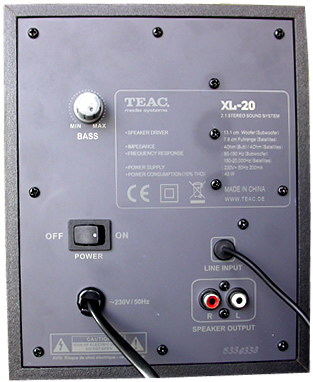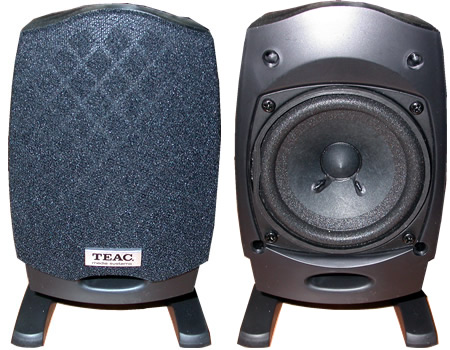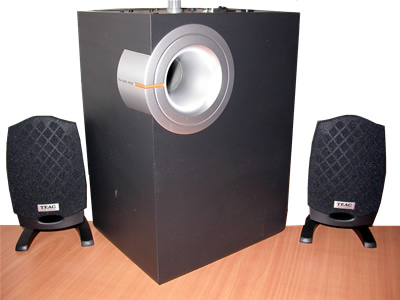1. Introduction

For many reasons, 2.1 speaker sets have become an essential item in anyone's
arsenal of PC accessories. They are certainly more affordable than 5.1
systems, they sit well next to your PC monitor without a multitude of wires, they don't require you to be a sound engineer to connect and set them up andl
ast but certainly not least, they usually offer adequate sound
performance. Considering that the majority of PC users spend more than the
70% of their PC time playing games or their favorite MP3 music files, having
a good quality multi-channel speaker system to reproduce your
gameplay special effects or favorite music tracks in stereo is mandatory.
Obviously, a 2.1 system only reproduces stereo so you won't be able to get
the benefits of 5.1 surround sound. While most music is still almost
exclusively in stereo, it's really only an issue for DVDs and games where
surround sound is a real plus. However, some 3D-sound simulation systems,
while they can't really compete with a true surround system, can improve
results. Multimedia 2.1 systems have become a lot better and offer real
quality sound reproduction at a very accessible price.
We looked at and listened to a 2.1 system priced at under $40 from Teac, the
XL-20. The Japanese company has always been known for their exceptional
recording equipment, especially amongst recording industry professionals to whom they cater. In more recent times, TEAC's consumer products have been
geared more towards the low end of the audio market.
With the XL-20 2.1 speaker set, TEAC focuses on the PC user who needs a
quality, yet affordable audio system. For all those who are not familiar
with 2.1 channel audio systems, the XL-20 consists of two satellite speakers
along with a subwoofer. Generally, the satellite speakers reproduce the high
and mid-range frequencies of an audio signal, which means that they are
responsible for the quality of vocals and music, or any other sound except
the bass. The latter is reproduced by the subwoofer, which is the speaker
for all the low frequencies of an audio signal. The quality of the subwoofer
is very important since it would determine whether the rocket-launcher and
grenade explosions in your games will rumble in your room with realism, or
the bass line and the kick drum rock the walls when you playback your
favorite songs.
 Looking at TEAC's XL-20 system, we would say that it really excels with its
space-age design. The magnetic-shielded subwoofer cabinet, looks solid and
its compact size allows it to easily fit under a desk or table. The inside
of the peaker driver hides a 13.1 cm woofer - large enough for good bass
response - that blasts up to 12 watts (RMS) of bass output although not
exactly what would make the floor tremble. The silver bass-reflex port
opening is the only opening on the subwoofer and is found on the front. TEAC
added some rubber feet at the bottom of the unit to help keep it firmly in
place.
Looking at TEAC's XL-20 system, we would say that it really excels with its
space-age design. The magnetic-shielded subwoofer cabinet, looks solid and
its compact size allows it to easily fit under a desk or table. The inside
of the peaker driver hides a 13.1 cm woofer - large enough for good bass
response - that blasts up to 12 watts (RMS) of bass output although not
exactly what would make the floor tremble. The silver bass-reflex port
opening is the only opening on the subwoofer and is found on the front. TEAC
added some rubber feet at the bottom of the unit to help keep it firmly in
place.
On the right side of the subwoofer, you will find a 3.5 mm stereo input jack and
also the line-in cable that connects to your sound card (analogue stereo source).
The same cable also leads to the wired remote control. One positive point
here is the absence of an external power transformer, which would add a little
more clutter to the mess of cables that are probably already dangling from
your machine. All you need to power up the system, is to plug the power cable
directly to a 230 volt~50Hz plug and press the Power ON switch, located on
the right side. Lastly, you should connect the satellite
(L&R) speakers to the corresponding speaker inputs, as well as a bass level
control knob.

The two 2.54 cm Mylar Membrane full range satellites feature a small footprint
so they will easily fit either side of any monitor. Each satellite outputs
8 Watts (2 x 8 Watts) and feature a small bass reflex opening, as illustrated
in the photo below. In general, such openings improve the frequency response
of a speaker since it acts like a high-pass filter. Note
that the satellites are connected to the subwoofer unit through pluggable
connectors and not directly, allowing you to extend the length of the cables
in order to place the satellites away from your desktop.

As we previously mentioned, a wired remote control unit is on the input-line of
the device, although it would be more convenient if it could be located somewhere
between the two speakers. As you can see below, ergonomics is no problem -
the unit looks quite stylish and is very easy to use. The big volume control
knob is sensitive, while an easier to find mute knob would be
very convenient. When the mute button is not enabled, a nice blue LED lets
you know there is power going to the system. With the controls on a separate
unit, it gives the satellite speakers a very clean look. What we should note
is the headphone jack placed on the remote control. However, when you listen
to music through the headphones, the audio lacks any real bass since the
subwoofer is bypassed.

Features:
3 built-in amplifiers
Mylar membrane satellites
magnetic shielded subwoofer.
Control Panel Volume, Treble and Bass Control, Power Led
Technical specifications:
Peak power output: 70 W
Main supply 230 Volt~50 Hz, 0.12 A
Subwoofer
135 mm driver
Frequency range 50-150 Hz
Power output (RMS): 15 W
Dimensions (WxHxD): 158 x 200 x 286 mm
Satellites
Magnetic shielded Mylar Full Range
78 mm driver
Frequency range 150-20,000 Hz
Power output (RMS): 2 x 10 W
Dimensions (WxHxD): 95 x 160 x 108 mm
Accessories: Connection Cables, Wired Remote Control
2. Setup and Use
As you can imagine, setting up the Teac XL-20 speakers is incredibly easy.
Since the system is only a 2.1 setup you will not have to worry about
running cables around the room or positioning four satellite speakers. The
cable that the satellite speakers are connected to features two separate
cables. There is just enough cable available to set one satellite on each
corner of a 1,5 m wide desk. Once you have the satellites where you want
them, plug them into the subwoofer, connect the subwoofer to your computer
and power the system up.
Evaluating a sound speaker system requires both objective and subjective
tests. However, for this presentation we will just present our thoughts and
our overall impression for the system, which someone could claimed that
they lack of technical objectivity.
We used the Teac Xl-20 system for more than 15 hours in an attempt to see
how it performs compared to the strong competition for the same price tag.
Playback of various music included classical music for precision in sounds,
while Games like Unreal Tournament 2004, Doom III, and Need For Speed Most
Wanted were tested for environmental sounds. In addition, music from
Metallica as well as some dance anthems was selected to test bass, volume
levels and noise clarity. Last, we used some of the latest Hollywood DVD
releases.
The Xl-20 sound system could be ideal for anyone who likes listening at a
reasonable level. Although you'll have all enough power for close-up
listening on your desktop, filling a room could be a problem. The strong
part of the system is that the reproduction had good overall timbre, without
overemphasizing the high frequencies like many micro driver systems.

But where bass is concerned, you have to limit your expectations. The
relatively low volume of the subwoofer enclosure can't match the depth
larger models can deliver. Sound effects such as explosions and the like
obviously lack the impact they have on a more powerful system. In order to
achieve better bass reproduction, you should set the bass knob almost at its
higher value, just before the distortion limit.
The sound deteriorates if you try to crank up the volume. The limited
amplification power and the capacities of the micro drivers add up to
distortion which comes noticeable as soon as you push the bass amplifier to
its limits. Going a little further, we could add that definition is limited
in the midrange, but that's certainly the aspect that's easiest to accept.
After all, you should not expect speakers of this category to compare to
studio sound.
While gaming, the system performed decently, although it soon became obvious
that the subwoofer and satellites are not tuned for recreating explosions,
sound effects and screaming engines with precise accuracy.
In the music listening tests, the XL-20 was acceptable. Listening was
enjoyable but we would like a stronger offering. Let's say the system gets
an average rating here.
The Teac Xl-20 does it well with sounds effects of a DVD movie, where music
takes a background role. Overall, the movie experience was adequate, but
with only 15 watts of power, it was not earth shattering in any sense.
So the overall assessment is mixed. This is definitely not a system that
will rattle the windows, but with 15 watts of power available - the system
is more than effective. The Xl-20 is a possible choice if you're looking
above all for a small-footprint speaker kit with modern esthetics, but it's
still a compromise between esthetics and quality sound. It's a compromise
you may be willing to make when you think that it's just 30-40 euros you'll
have to spend.